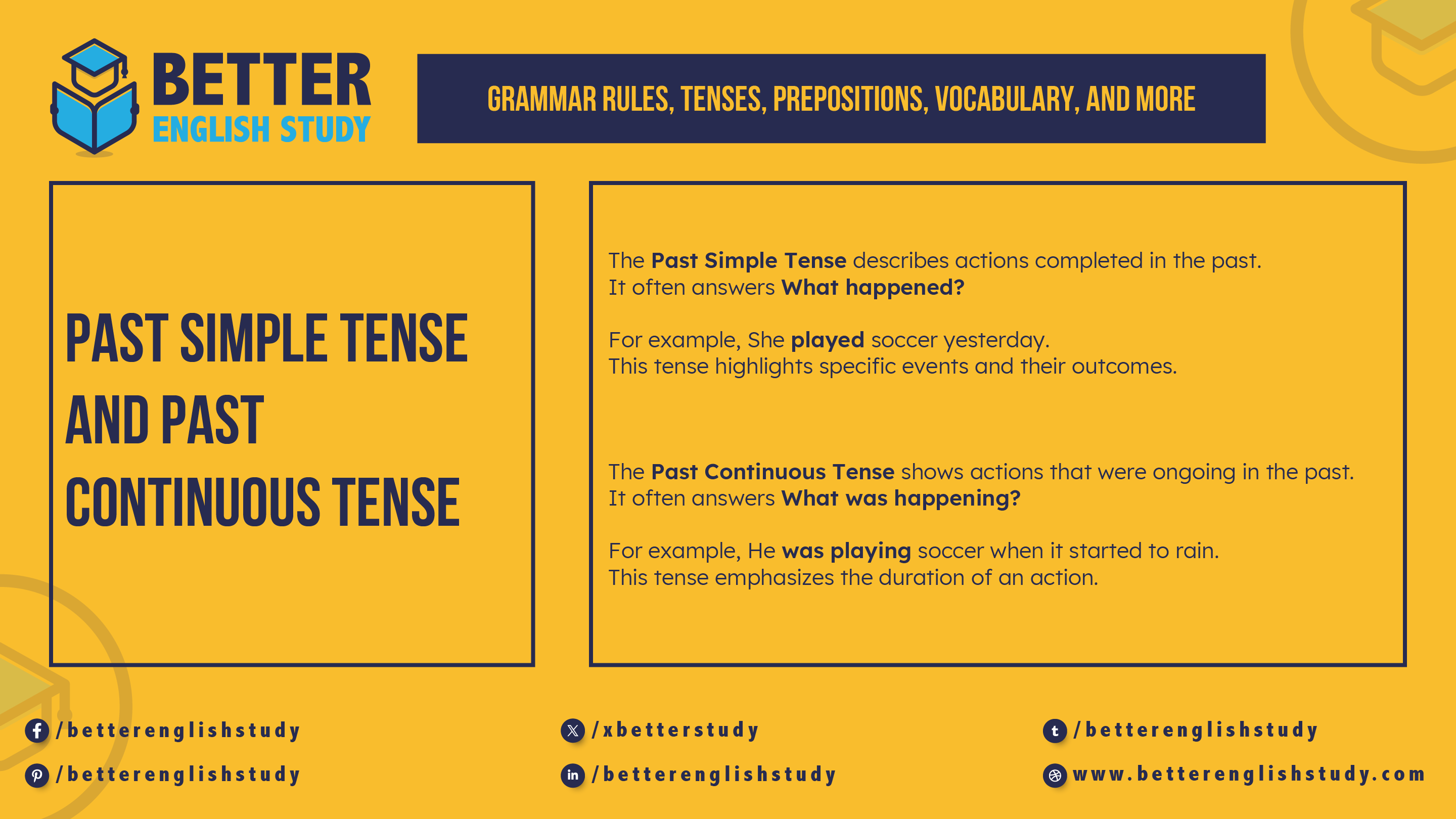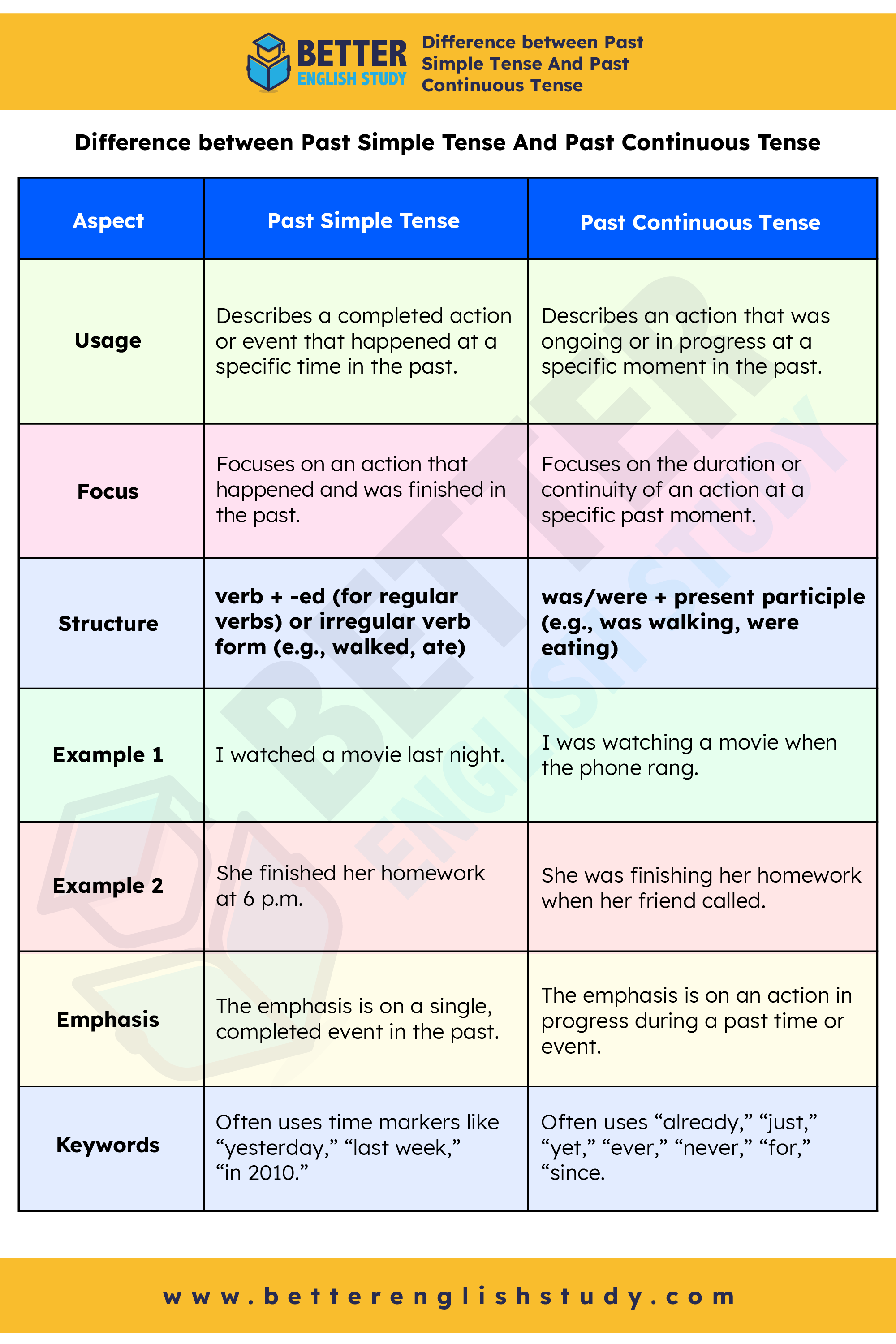
The Past Simple Tense describes completed actions at a specific time, while the Past Continuous Tense shows ongoing actions in the past. For example, “I walked to the store” (Past Simple) contrasts with “I was walking to the store” (Past Continuous).
Understanding the difference between Past Simple and Past Continuous tenses is crucial for effective communication. The Past Simple Tense conveys actions that happened and ended at a specific moment, often accompanied by time markers like “yesterday” or “last week. ” On the other hand, the Past Continuous Tense emphasizes the duration or ongoing nature of an action in the past, often setting the scene for another action.
Recognizing these nuances enhances your writing and speaking skills, making your narratives more vivid and engaging.
Introduction To Past Tenses
The Past Simple Tense describes actions completed in the past. It often answers “What happened?” For example, “She played soccer yesterday.” This tense highlights specific events and their outcomes.
The Past Continuous Tense shows actions that were ongoing in the past. It often answers “What was happening?” For example, “He was playing soccer when it started to rain.” This tense emphasizes the duration of an action.
Understanding these tenses is important for clear communication. Using them correctly helps convey time and action effectively. Mastery of these tenses strengthens your English grammar skills.
Basics Of Past Simple Tense
The Past Simple Tense shows actions that happened in the past. It often uses the -ed form for regular verbs. For example, “I walked to the park.” Irregular verbs change form. An example is “I ate an apple.”
Common uses include describing completed actions. It also tells about past habits. For instance, “She played soccer every Saturday.” Time expressions often accompany it, like “yesterday” or “last week.”
Here is a simple table showing formation:
| Type of Verb | Example |
|---|---|
| Regular Verb | walked |
| Irregular Verb | ate |
Diving Into Past Continuous Tense
The Past Continuous Tense is formed using the verb “to be” and the -ing form of the main verb. For example, “was eating” or “were playing” shows actions that were ongoing in the past.
Key uses of the Past Continuous Tense include:
- Describing actions that were happening at a specific time in the past.
- Indicating that one action was interrupted by another action.
- Setting the scene in a story.
For instance, “I was reading a book when she called.” This shows the reading was ongoing.

Difference between Past Simple Tense And Past Continuous Tense
| Aspect | Past Simple Tense | Past Continuous Tense |
|---|---|---|
| Usage | Describes a completed action or event that happened at a specific time in the past. | Describes an action that was ongoing or in progress at a specific moment in the past. |
| Focus | Focuses on an action that happened and was finished in the past. | Focuses on the duration or continuity of an action at a specific past moment. |
| Structure | verb + -ed (for regular verbs) or irregular verb form (e.g., walked, ate) | was/were + present participle (e.g., was walking, were eating) |
| Example 1 | I watched a movie last night. | I was watching a movie when the phone rang. |
| Example 2 | She finished her homework at 6 p.m. | She was finishing her homework when her friend called. |
| Emphasis | The emphasis is on a single, completed event in the past. | The emphasis is on an action in progress during a past time or event. |
| Keywords | Often uses time markers like “yesterday,” “last week,” “in 2010.” | Often uses time expressions like “when,” “while,” “at 5 p.m.” |
- Past simple describes actions that happened and were completed in the past.
- Past continuous describes actions that were in progress at a specific time or when another action occurred.
Significance Of Time Markers
Time markers help to identify the Past Simple and Past Continuous tenses. They indicate when an action took place. Common time markers for Past Simple include “yesterday,” “last week,” and “in 2010.” These words show that the action is complete.
For Past Continuous, time markers like “was,” “were,” and “during” are used. These words show an action that was ongoing in the past. For example, “I was playing” indicates that the action was happening at a specific time.
| Past Simple | Past Continuous |
|---|---|
| Completed actions | Ongoing actions |
| Specific time markers | Describes background actions |
Examples To Clarify
The Past Simple Tense shows completed actions. For example, “I walked to the park.” This indicates the action is finished. Another example is, “She played soccer yesterday.” This sentence tells us about a specific time.
The Past Continuous Tense describes actions in progress at a certain time. For instance, “I was walking to the park.” This means the action was ongoing. Another example is, “She was playing soccer when it started to rain.” This shows two actions happening together.
Common Mistakes And Misunderstandings
Many students make mistakes by mixing tenses. They might use the past simple and past continuous tenses incorrectly. For example, saying “I was played soccer” instead of “I played soccer” is common.
Overgeneralization occurs when students apply rules too broadly. They might think all actions in the past use past simple tense. This is not true. The past continuous tense shows an ongoing action.
Consider these examples:
- Past Simple: I walked to school.
- Past Continuous: I was walking to school.
Using the correct tense helps convey the right meaning.
Practical Applications
Using the Past Simple Tense is essential for stating completed actions. For example, “I played soccer yesterday.” This shows a clear action done in the past.
The Past Continuous Tense describes actions that were ongoing. For instance, “I was playing soccer when it started to rain.” This shows two actions happening at the same time.
When writing, use the Past Simple for quick facts. Use the Past Continuous to add detail and background. This helps readers understand the context better.
For speaking fluently, practice switching between these tenses. Try making sentences about your day. Use both tenses to describe completed actions and ongoing situations.
Frequently Asked Questions
What Is Past Simple Tense?
Past Simple Tense describes completed actions in the past. It often uses regular verbs ending in “-ed” or irregular verbs with unique forms. For example, “I walked to the store” indicates a finished action. This tense is essential for narrating past events clearly.
What Is Past Continuous Tense?
Past Continuous Tense expresses ongoing actions in the past. It is formed with “was/were” plus the verb ending in “-ing. ” For instance, “I was walking to the store” shows an action in progress. This tense helps set the scene or provide context in storytelling.
How Do Past Simple And Past Continuous Differ?
The main difference lies in their focus. Past Simple emphasizes completed actions, while Past Continuous highlights ongoing actions. For example, “I read a book” (simple) versus “I was reading a book” (continuous). Understanding this distinction is crucial for effective communication in English.
When To Use Past Simple Vs. Past Continuous?
Use Past Simple for actions that are finished. Use Past Continuous for actions that were in progress at a specific time. For example, “I was studying when he called” shows an ongoing action interrupted by another event. Choosing the correct tense enhances clarity in your writing.
Conclusion
Understanding the difference between past simple and past continuous tenses enhances your writing clarity. The past simple tense focuses on completed actions, while the past continuous describes ongoing actions in the past. Mastering these tenses will improve your grammar skills and make your storytelling more engaging.
Practice using both tenses for better communication.
